CHAPTER ELEVEN
THE BIGGER PICTURE
As with most of Kubrick’s later works (from 2001: A Space Odyssey onwards) The Shining operates on multiple paradigms. In the last chapter we discovered that the so-called “Making Of” documentary was not a genuine documentary at all, but a symbolic parallel of the feature film content. Now let’s explore another paradigm shift that has been subliminally encoded.
As previously cited, the distant views of The Overlook were shot at a real hotel location in America, called The Timberline Lodge. In particular our first view of Timberline is an aerial shot, and an important detail is that there is no hedge maze next to the hotel.

This has widely been considered a continuity error, but in my opinion the shot is just a little too blatant in its revelation of the surrounding terrain of Timberline. Kubrick instructed camera crews to shoot hours upon hours of helicopter footage in his absence because he didn’t like flying in airplanes, especially across the Atlantic. So instead the footage was shot by a separate crew and sent back to him. Surely his instructions would have been meticulous, as usual, and therefore he would have requested multiple aerial takes of the Timberline Lodge from different distances and different altitudes. He also would have taken into account that aerial shots would reveal the absence of a maze in the hotel grounds. If Kubrick wanted the exterior shots of the Overlook to give the impression that the maze existed somewhere off screen or behind part of the hotel then he could have very easily achieved it.
On that basis, it’s worth considering the possibility that, just like the deliberately disorientating spatial “errors” in the Overlook’s interior sets, this glaring exterior continuity error is part of another subliminal theme.
Actually, I’ve found that there are several paradigm shifts operating in the distant hotel exterior shots. In this chapter we’ll explore two of them. The first is that the Maze and the Overlook hotel are symbolically one and the same. In chapter four we explored in detail the theme of the Overlook being a maze, and we explored that both the hotel and the hedge maze dramatically change their layouts between scenes. Here are a collection of further details that subliminally merge the hotel and maze as being one and the same.
- As Ullman introduces the maze to Jack and Wendy they are actually walking towards the Overlook, which scrolls on screen from our left. “This is our famous hedge maze … And the hedge is about as old as the hotel itself.” The identical age between the hotel and maze is a clue of their cross-symbolism, but how can Ullman be introducing the maze as they walk away from the maze entrance? Just a couple of scenes before this Ullman was showing the Torrance’s the Colorado Lounge, which is inside the hotel, so shouldn’t they be walking from the Overlook as he introduces the “famous hedge maze”. If we think of the hotel and maze as being symbolically interchangeable this directional contradiction makes much more sense. Ullman and the Torrance’s have just walked out of the maze entrance after seeing the Colorado Lounge and so his description of a “famous hedge maze” is referring to the hotel itself.
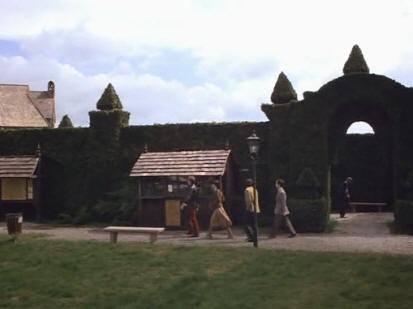 
- It was also noted in chapter four that the Overlook exterior is designed with large sections at odd angles to each other, but that all of the interior sets feature rooms and hallways positioned at perfect right angles, which matches up with the squared design of the hedge maze.
- As Ullman explains the hedge maze, there are a series of triangular or pyramid shaped trimmings periodically positioned along the top of the maze’s outer walls. Compare this to the hotel. The roof design features similar triangle shapes. It seems Kubrick had the hedge maze sets designed to mimic the exterior roof patterns of the Timberline Lodge.
 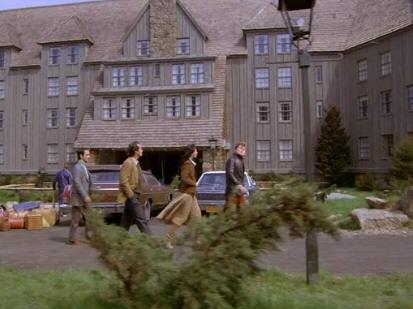
- At several points in The Shining we see distant views of The Overlook from a position parallel to the hotel base (with a mountain in the background). As the shots change from summer to winter throughout the film, they also shift from day shots to night shots, with an increasing amount of snow built up against the walls and with an increasing number of lit windows. The hotel is gradually beginning to look like a flat exterior wall of the hedge maze.
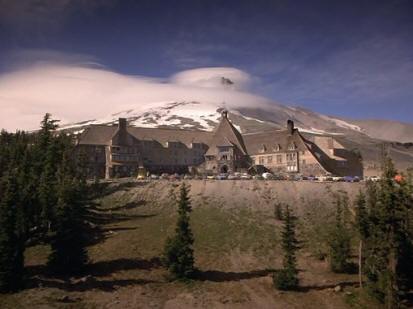     
- By the time we get to the maze chase at the end, the exteriors of the Overlook and hedge maze look incredibly alike.
 
- Kubrick’s choice to put lights inside the maze is also interesting. I’ve looked around online at lots of real life hedge mazes and I’m yet to find one that has internal lights. Mazes are not intended as a night time or winter activity. It would also be pretty irresponsible of The Overlook Hotel’s management to allow the maze to be accessible during the freezing winter. A gate and padlock would be required for health and safety. The lights along the hedge walls inside the maze parallel the spatially impossible windows inside the Overlook, which also seem to generate their own artificial light.

- As Wendy and Danny wonder around the maze in the daytime the shot fades to Jack wandering around the hotel lobby, again cross symbolizing the two locations.
- And as Wendy and Danny walk through the centre of the hedge maze she comments, “Isn’t it beautiful”. On her first day at the Overlook she made the same comment about the Colorado Lounge, “Wow. It’s beautiful”. The Colorado Lounge is a parallel of the hedge maze centre.
- In one of the scenes missing from the European DVD release Wendy runs from the Goldroom hall into the lobby and sees skeletons, but all the lights are out and Halloran's body is gone. This is strange because several of these lights were on when Jack killed Halloran in the same location. He immediately gave chase to Danny and so wouldn’t have turned back to switch out the lights. However, due to Jack switching on the exterior lights, the lobby is now lit through the windows in a way that mimics the hazy blue lighting of the maze interior.

- Notice also in the skelton scene that the windows in the Gold Room hallway are lit by extremely close up light sources, as if they are the hotel equivalant of the halogen light alcoves in the maze.
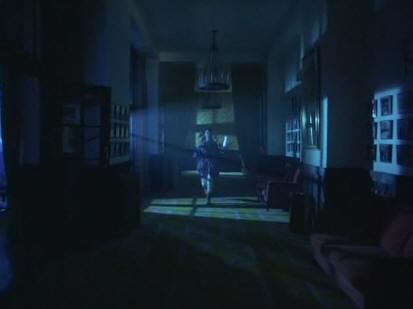
- Even the maze map that we see in the grounds is titled “The Overlook Maze”.
Shifting to a different paradigm Kubrick offers us the concept of a fractal maze – of mazes within mazes.
- The most unmistakable example of this is that when Jack looks down on the table top maze. We see Danny and Wendy walking around the maze centre as if they were ant-sized, but the really interesting thing here is that the shadow angles cast by the walls are perfectly matched by the shadow angles inside the actual hedge maze (as seen in the steadicam shot of Danny and Wendy that immediately follows).
 
- Another example of fractal mazes is that Danny is seen playing with his toy cars on the spaghetti-like carpets near room 237, as if the windy patterns represent tiny roads. This is a small scale parallel of Jack’s car driving through windy mountain roads in the film’s opening. Danny even uses a yellow toy car, just like his father has a life sized yellow car.
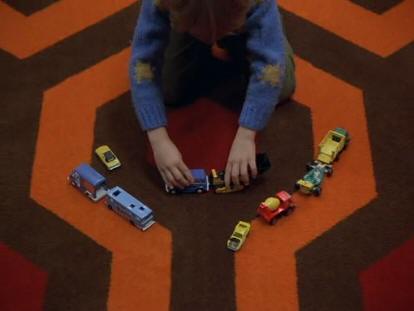   
- Another possible hint relating to toy cars is that when Danny and Wendy are having snowball fights, the start of the shot shows the Sno-cat vehicle outside the garage, as if someone has been riding it about and then left it lying around like Danny’s tricycle.

- And then of course Danny’s tricycle being chased by a camera mimics Jack’s car being chased by a camera.
So this concept of mazes within mazes doesn’t only manifest at the child’s play scale. It also extends beyond the walls of the hotel. The mountain ranges and roads are a grand scale version of the Overlook, which itself looks like a series of mountain peaks. The tallest peak of the Overlook roof is repeatedly framed by a mountain in the background, a simple cross symbolism metaphor.

Perhaps we are to take from this that the Overlook hotel is a representation of America. As Wendy says when walking in the centre of the maze, “I didn’t think it was gonna be this big. Did you?” The table top maze that Jack watched them in seemed to have no edges, as if it went on forever in all directions and the centre was the exit. When Danny and Wendy were racing each other into the maze, Danny said, “The loser has to keep America clean”. Being that Wendy seems to do all of the work in the Overlook, while Jack writes, it would seem she is keeping America clean.
Another example of the mountain ranges being part of a huge coast to coast maze is seen when Halloran is driving to the Overlook in his Sno-cat. He drives down a snowy path, flanked by rows of pine trees – the image parallels Danny and Jack running through the maze.
 
So why would Kubrick go to all these efforts to create a paradigm of the Overlook hotel as a representation of the United States a whole? The answer is traight forward. Kubrick wanted to create parallels between the surface horror story narrative and his own thoughts on the history of the United States.
PREVIOUS CHAPTER
NEXT CHAPTER
CHAPTER LIST
MAIN SITE PAGE
|
























